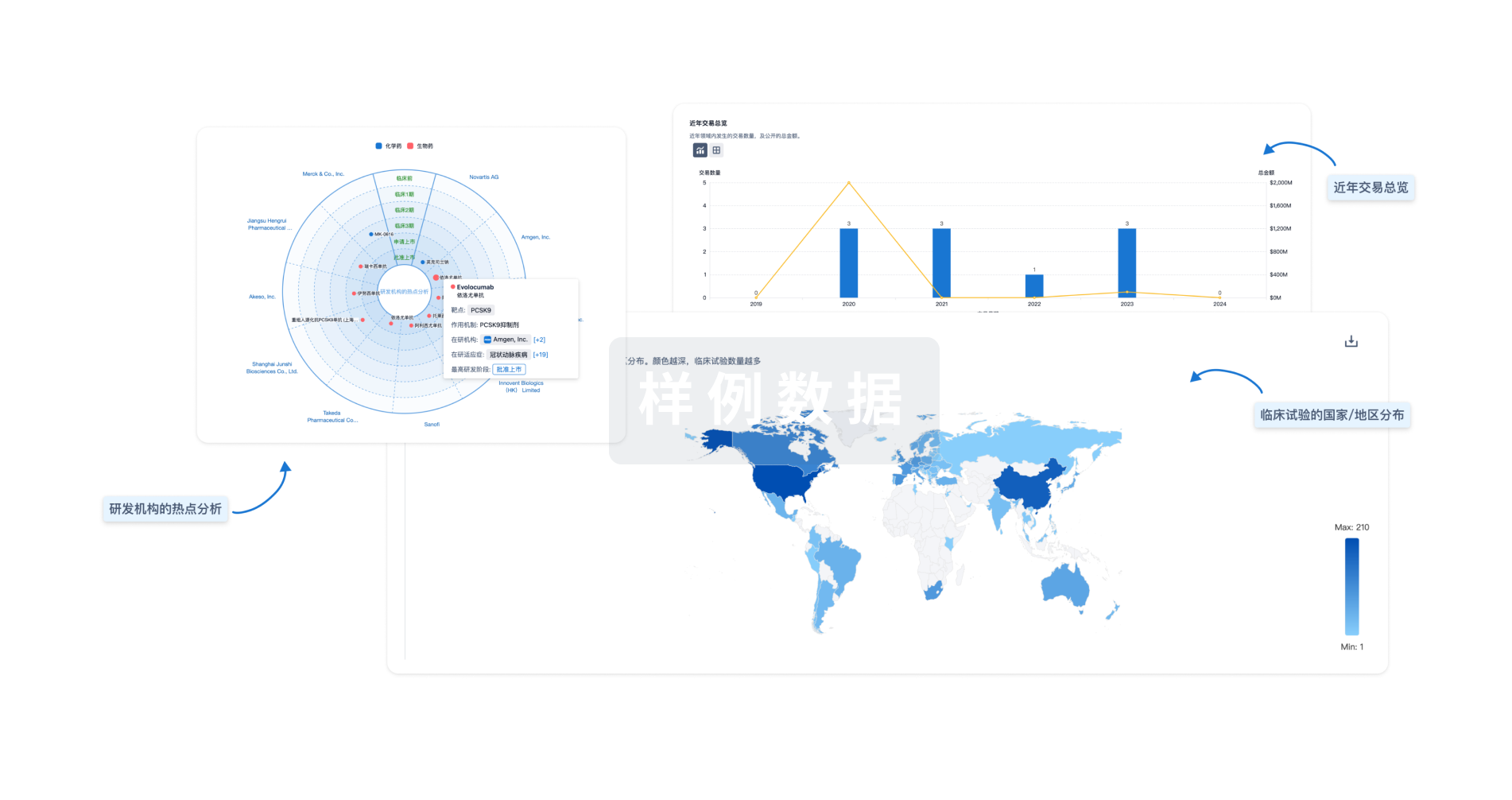预约演示
更新于:2025-05-07
ASPSCR1
更新于:2025-05-07
基本信息
别名 Alveolar soft part sarcoma chromosomal region candidate gene 1 protein、Alveolar soft part sarcoma locus、ASPL + [10] |
简介 Tethering protein that sequesters GLUT4-containing vesicles in the cytoplasm in the absence of insulin. Modulates the amount of GLUT4 that is available at the cell surface (By similarity). Enhances VCP methylation catalyzed by VCPKMT. |
关联
100 项与 ASPSCR1 相关的临床结果
登录后查看更多信息
100 项与 ASPSCR1 相关的转化医学
登录后查看更多信息
0 项与 ASPSCR1 相关的专利(医药)
登录后查看更多信息
358
项与 ASPSCR1 相关的文献(医药)2025-06-01·Modern Pathology
Molecular Characterization of TFE3-Rearranged Renal Cell Carcinoma in Children and Adolescents
Article
作者: Shen, Pengfei ; Sun, Guangxi ; Zhao, Junjie ; Nie, Ling ; Tang, Yanfeng ; Zhu, Sha ; Chen, Ni ; Yang, Nanshan ; He, Sike ; Yin, Xiaoxue ; Zeng, Xiaoxi ; Zeng, Hao ; Liu, Zhenhua ; Liang, Jiayu ; Zhao, Jinge ; Zhang, Xingming ; Guo, Jingjing ; Chen, Yuntian ; Liu, Haolin ; Hu, Xu ; Liu, Haoyang ; Chen, Junru
2025-04-01·International Journal of Biological Macromolecules
Extraction, structural characteristics, bioactivities and application of polysaccharides from Acanthopanax senticosus (Rupr. Maxim.) harms: A review
Review
作者: Jiang, Jiaxin ; Han, Ying ; Yan, Guangli ; Wang, Xiaoyu ; Wang, Xijun ; Han, Di ; Kong, Ling ; Liang, Qichao ; Sun, Hui ; Zhang, Xiwu
2025-03-01·Human Pathology
TFE3-rearranged ossifying fibromyxoid tumors are uniquely negative for glycoprotein non-metastatic melanoma protein B: A study of 13 TFE3-rearranged mesenchymal tumors
Article
作者: Hofich, Christopher D ; Folpe, Andrew L ; Cheville, John C ; Alvand, Saba ; Gupta, Sounak ; Whaley, Rumeal D ; Halling, Kevin C ; Dasari, Surendra ; Pujari, Ganesh P ; McCarthy, Michael ; Tekin, Burak
2
项与 ASPSCR1 相关的新闻(医药)2024-11-20
·生物世界
编辑丨王多鱼
排版丨水成文
在病毒感染的时候,机体细胞通过RIG-I样受体(RLR,主要包括RIG-I和MDA5)感知病毒RNA并启动早期抗病毒免疫反应。在识别病毒RNA后,RIG-I和MDA5与线粒体抗病毒信号蛋白MAVS组装形成复合物并进一步招募激活IRF3和NF-κB从而强烈诱导I/III型干扰素和大量促炎基因的转录表达。然而,RLR必须受到精准调控来区分病原和自身RNA, 从而避免诸如I型糖尿病、Aicardi–Goutières综合征和皮肌炎等自身免疫性疾病发生。
目前,机体对RLR及其下游信号蛋白的主要调控机制是翻译后修饰(PTM),哺乳动物体内是否存在其他对RLR及其上游的精准调控机制,仍不完全清楚。另一方面,模式识别受体(PRR)的激活会导致葡萄糖内流(glucose influx)增加、糖酵解(glycolysis)增强、三羧酸(TCA)循环的破坏以及代谢物的积累。同样,RNA病毒感染也会促进代谢重编程,这些代谢物会通过MAVS反馈抑制RLR信号传导,这种细胞代谢的重构依赖于葡萄糖转运蛋白(GLUT)。目前已发现先天免疫细胞上的Toll样受体(TLR)激活后,GLUT1可以促进细胞的糖酵解重编程【1】。然而,其他GLUT在先天免疫中的作用却完全未知。GLUT4是脂肪组织、骨骼肌和心肌中主要的胰岛素/肌肉收缩调节的葡萄糖转运蛋白,对于维持全身葡萄糖稳态至关重要。在静息状态下,GLUT4主要被隔离在细胞内的GLUT4储存囊泡(GSV)中,这些囊泡通过与高尔基体上的UBXN9(TUG)分子相互作用锚定在Golgi基质中【2】。胰岛素则通过特异性部位的内切蛋白酶切割UBXN9,从而释放GSV,使其运输至质膜,从而使GLUT4在细胞膜上发挥葡萄糖转运作用【3】。令人感兴趣的是,GLUT4是否具有其他生物学功能,尤其是免疫相关的功能目前完全未知。
2024年11月20日,美国康涅狄格大学医学院王鹏华团队在 Nature Immunology 期刊发表了题为:UBXN9 governs GLUT4-mediated spatial confinement of RIG-I-like receptors and signaling 的研究论文。
该研究利用CRISPR-Cas9基因敲除、RNA病毒感染细胞和小鼠等多种体内外模型,发现了UBXN9-GLUT4轴在调控RLR信号转导和抗病毒免疫反应中的全新作用,这一作用不依赖于GLUT4作为葡萄糖转运体的经典功能。与当前认为GLUT支持PRR激活响应的观点相反,该研究发现GLUT4通过空间拖拽并将RLR限域于细胞膜,从而显著减弱抗病毒免疫反应;并进一步揭示UBXN9通过将GLUT4锚定在高尔基体基质来调控这一过程,从而维持正常的RLR信号转导。重要的是,这一机制可能在自身免疫性疾病中起作用,研究者在自身炎性皮肌病患者中观察到了相一致的结果。
研究团队首先在高表达GLUT4的原代、传代肌细胞和小鼠实验中发现, 敲除UBXN9会明显减弱由RIG-I和MDA5及其下游信号分子TBK1和IRF3介导的抗病毒免疫反应。而在不表达GLUT4的骨髓来源巨噬细胞和A549肺上皮细胞中,UBXN9的缺失并不影响这一抗病毒免疫反应过程,因此可见UBXN9特异性调控典型表达GLUT4的骨骼肌的RLR信号通路激活。肌肉特异性的RNA病毒(Encephalomyocarditis virus,EMCV和O'nyong-nyong virus,ONNV)感染模型实验也进一步验证了这一结果;Ubxn9-/-小鼠对致死量EMCV感染更敏感,显示出更高的死亡率,伴随心脏和循环中高病毒载量和低血清干扰素(IFN-β)水平;同样,ONNV感染的Ubxn9-/-小鼠骨骼肌中可以检出比WT小鼠更高的病毒载量。这些结果表明UBXN9促进RLR识别不同的RNA病毒并激活抗病毒反应。
接下来,研究团队在肌细胞和hiPSC诱导的心肌细胞中发现,敲除或敲减GLUT4(Slc2a4)均可以显著增加RIG-I和MDA5激活介导的抗病毒免疫反应,肌肉特异性敲除GLUT4小鼠实验也证明了这一结果,表明GLUT4抑制RLR信号并促进RNA病毒感染。
最近的研究表明乳酸可以影响MAVS寡聚激活并抑制RLR信号,但是,区别于研究人员一开始的推测UBXN9敲除对RLR信号激活的减轻作用是由于葡萄糖内流和升高的循环中乳酸水平导致的, 尽管证实UBXN9是体内GLUT4的主要调控分子,但是研究团队发现GLUT4对RLR的调控与葡萄糖摄取和乳酸产生水平无关。进一步的实验提示RLR激活可以诱导GLUT4转位,同时UBXN9以GLUT4依赖的方式增强IFN-β产生。
通过RLR-MAVS互作试验和MAVS寡聚试验,研究团队推测UBXN9-GLUT4作用于RLR信号通路的最上游,接下来,研究团队通过3T3-L1-myc-GLUT4-GFP脂肪细胞系发现,急性胰岛素刺激将GLUT4从核周区域快速转位至细胞膜后会显著抑制IFN-β产生,并且观察到胰岛素和3p-hpRNA(促进GLUT4转位至胞膜)显著增加细胞膜上的RIG-I分子,而Slc2a4-/-细胞的胞膜上几乎检测不到RIG-I的存在,提示RIG-I分子的膜转位依赖于GLUT4。在骨骼肌细胞中分离细胞膜、细胞浆和粗分线粒体组分以及VSV和EMCV感染实验进一步证实在病毒感染的过程中,GLUT4调控RIG-I的胞内重分布至细胞膜从而显著降低RLR抗病毒信号通路激活。分子克隆实验证实GLUT4通过膜内的C-terminal和loop6结构域与RLR的CARD结构域相结合并将RLR转位锚定至细胞膜上。
为了理解病毒感染期间GLUT4依赖性的RLR锚定是如何发生的,研究团队聚焦于PI3K-AKT、AMPK以及c-Cbl-TC10α介导的GLUT4转运路径中的保守上游节点,并发现病毒感染通过激活AKT/AMPK及c-Cbl信号通路进一步诱导UBXN9的剪切和GSVs囊泡的释放,释放的GSVs-GLUT4将RLRs转位锚定至细胞膜。
最后,研究团队观察分析了一种临床上的自身免疫性疾病-皮肌炎中的RLR和GLUT4的表达和调控情况,这类疾病以骨骼肌炎症和衰弱、升高的促炎因子表达谱和RIG-I水平为特征,这些病人样板的转录组表达谱进一步证实低表达的GLUT4及其相关基因谱与升高的RLR水平及ISG表达谱之前的紧密关联。
总的来说,这项研究揭示了一种非典型的UBXN9-GLUT4轴介导空间限域作为控制RLR信号传导的主要策略,并揭示了GLUT4在调节先天免疫中的一种与葡萄糖无关的功能。该研究创新了对RLR抗病毒免疫的理解,为未来研究RLR空间调控深入细节以及RLR信号传导在代谢性和自身炎性疾病中的作用提供了新的思路。
王鹏华研究团队(Wang Lab)今年已发表多篇高水平研究论文,包括2024年1月在Nature Communications发表了题为:UBR5 promotes antiviral immunity by disengaging the transcriptional brake on RIG-I like receptors 的研究论文【2】。该研究通过对375个E3泛素连接酶的CRISPR-Cas9单基因敲除筛选发现E3泛素连接酶UBR5可以通过K63泛素化减弱TRIM28的SUMO化,消除TRIM28对RLR转录的抑制作用,上调RLR的表达,增强机体细胞抗病毒免疫反应。该研究发现了RLR的新的调控机制,提出了抗病毒感染治疗中的一个新的治疗干预靶点。
2024年8月在Lancet子刊eBioMedicine发表了题为:UBXN3B is crucial for B lymphopoiesis 的研究论文【3】,揭示UBXN3B在B细胞稳态和命运中的关键调控作用,证明了UBXN3B对于骨髓中从前体B细胞阶段的B淋巴细胞生成以及病毒特异性IgM/IgG的产生至关重要。UBXN3B在清除呼吸道病毒感染和限制肺部免疫病理方面发挥了关键作用。
康涅狄格大学医学院王鹏华教授为该最后通讯作者,其实验室博士生Andrew G. Harrison为论文第一作者,博士后杨多猛为论文共同通讯作者。
王鹏华教授
王鹏华,康涅狄格大学医学院(Uconn Health)教授,耶鲁大学客座教授。本科就读于中山大学,博士毕业于新加坡国立大学。博后在耶鲁大学研究病毒免疫和蚊虫病毒致病机理。现主攻模式识别受体, 如RLR、cGAS-STING、NLRP和Caspase-4/11在它们识别病原体、激活和调控等方面的机理。在病毒方面,研究蚊虫病毒和冠状病毒的致病,传播机理。以第一或通讯作者在Science、Nature Immunology、Nature Communications、EMBO、Trends in Immunology等国际顶级期刊发表多篇研究论文,目前共发表论文100多篇,包括多篇Cell、Science和Nature。
论文链接:
1. https://www.nature.com/articles/s41590-024-02004-7
2. https://www.nature.com/articles/s41467-024-45141-1
3. https://doi.org/10.1016/j.ebiom.2024.105248
设置星标,不错过精彩推文
开放转载
欢迎转发到朋友圈和微信群
微信加群
为促进前沿研究的传播和交流,我们组建了多个专业交流群,长按下方二维码,即可添加小编微信进群,由于申请人数较多,添加微信时请备注:学校/专业/姓名,如果是PI/教授,还请注明。
点在看,传递你的品味
基因疗法临床1期
2023-01-04
·生物谷
这项回顾性队列研究首次描述了中国HDGC患者的胚系变异特征,并且说明了中国患者与以往其他研究分析的患者在胚系变异特征差异较大,同时还提出了一些在中国HDGC患者中潜在的临床可操作性变异靶点
胃癌是全球第五大常见癌症,也是癌症死亡的第三大常见原因,在东亚人群中特别常见[1,2]。
尽管大部分的胃癌都是散发性的,但仍有约10%的病例表现出家族聚集性。根据已有报道,3%~5%的胃癌病例与遗传胃癌易感性综合征有关,这其中包括遗传性弥漫性胃癌(HDGC)、胃腺癌、胃近端息肉病以及家族性肠型胃癌[3,4]。
HDGC被认为是一种具有遗传倾向的胃癌,已有研究表明25%~50%的HDGC病例都携带CDH1或者CTNNA1上的胚系变异,但仍有50%~75%的HGDC病例的遗传机制还不明确[5],并且在东亚人群特别是中国人中CDH1的突变率也是未知的。
这就需要我国科学家来解决这个问题了。
近日,由中山大学肿瘤防治中心的徐瑞华和邱妙珍领衔的研究团队,在JAMA Network Open期刊发表重要研究成果[6]。
他们进行了一次回顾性队列分析,对来自284例HDGC患者的284份白细胞样本和配对的186个肿瘤样本做了全外显子以及靶向测序,发现在中国HDGC患者中CDH1的胚系变异突变率仅为2.8%,而体细胞变异突变率则有25.3%。
他们还发现,中国HDGC患者胚系变异突变率较高的一些基因与之前报道的基因并不一致,以及中国HDGC患者发病过程中可能存在遗传和环境因素的互作。
论文截图
徐瑞华团队对2002年1月1日至2018年8月31日之间,在中山大学肿瘤防治中心确诊为胃癌的10431例患者进行了回顾性分析,最终纳入分析的HDGC病例数为284(有两例HDGC患者来自于佛山第一人民医院)。
这284例HDGC患者大部分是III期或IV期患者(190例,66.9%),以及40岁前确诊弥漫性胃癌且无家族病史的患者(254例,89.4%)。患者确诊中位年龄为35岁,有161例(56.7%)为女性,中位随访期为21.7个月。仅有8(2.8%)例患者感染EB病毒,远低于之前报道的胃癌患者EB病毒感染率。患者5年存活率为61.4%,高于之前报道的散发性胃癌患者的44.1%。
接下来,研究团队对284例HDGC患者的白细胞样本以及配对的186个肿瘤样本,进行了全外显子测序。他们利用测序数据识别了患者携带的胚系变异和体细胞变异。
基于检测到的胚系变异,研究团队发现仅有8例患者携带CDH1上的变异,这与以往研究结果差异较大,并且患者携带的变异都是之前没有报道过的。这表明中国HDGC患者有着不一样的遗传背景和致病机制。
CDH1上的胚系变异和体细胞变异
除此之外,以往研究认为CTNNA1、BRCA2、STK11、SDHB、PRSS1、ATM、MSR1、PALB2、BRCA1以及RAD51C上的突变可能与CDH1野生型HDGC的易感性有关。但徐瑞华团队发现,在中国HDGC患者中这些基因的突变率仍然较低,并且发生的突变与以往的报道并不一致。
在中国HDGC患者中,胚系变异突变率最高的基因是MUC4(19%)、ABCA13(10%)、ZNF469(10%)、FCGBP(10%)、IGFN1(10%)、RNF213(10%)以及SSPO(10%),这些基因都是未曾报道过的。其中突变率最高的基因MUC4在53例患者中都发生了突变。有研究指出MUC4在小鼠中可能引起成纤维细胞的癌变,因此MUC4的过表达可能通过ERBB2通路促进胃癌的恶性化。
中国HDGC患者的胚系变异突变谱
利用配对的肿瘤样本,研究团队识别了186例HDGC患者的体细胞变异,突变率最高的基因是TP53(32.3%)。有趣的是,尽管CDH1的胚系变异突变率在中国HDGC患者中并不高,但是其体细胞变异突变率却高达25.3%。除此之外,研究团队还发现,在中国HDGC患者中HRCT1、KRTAP5-4等基因是显著突变基因(驱动基因)。
中国HDGC患者的体细胞变异图谱
随后徐瑞华团队比较了中国HDGC患者和TCGA散发性弥漫性胃腺癌(D-STAD)患者的体细胞变异负荷,发现两个队列的基因变异频率显著相关(R=0.24,P<2.2×10-16),但在一些基因上中国HDGC患者的突变率显著低于D-STAD患者,例如MLLT4在D-STAD患者中的突变率是10%,而在中国HDGC患者中为0%。
研究团队还比较了两个队列在PI3K-Akt、MAPK、Wnt以及TGF-β等胃癌发生发展过程中起重要作用的通路上的体细胞变异频率,发现D-STAD患者的变异频率要高于中国HDGC患者。
在体细胞变异基础上,研究团队还分析了HDGC患者的拷贝数变异,他们发现6p22.2和19p13.2是高频扩增区域,而1q21.2和10q21.3是高频缺失区域。具体到基因水平上,拷贝数变异频率较高的基因是PTK6(44.6%)、ERBB3(13.4%)和PIK3CA(11.8%),这三个基因都是胃癌中已知的癌基因。
中国HDGC患者拷贝数突变频率显著较高的区域
为了探究中国HDGC患者的病因,徐瑞华团队分析了所有样本的体细胞变异特征,并与COSMIC数据库中的变异特征进行了匹配。他们发现了3个主要特征,分别是(以COSMIC特征命名):特征1(5-甲基胞嘧啶自发性脱氨)、特征5(原因未知)、特征24(黄曲霉素暴露)。表明环境因素对HDGC的发生也起到了较大作用,并且可能存在遗传和环境因素的互作关系。
最后,徐瑞华团队分析了临床预后相关的变异。在胚系变异中,他们发现有7个基因上的变异与总生存期有关,分别是SDK1、HSPG2、FSIP2、CUBN、NCKAP5、FLNB以及MUC16。
在体细胞变异中则有大量的基因变异与总生存期有关,其中变异频率较高的基因是FGFR3(HR, 2.2)、ASPSCR1(HR, 2.2)、CIC(HR, 2.4)、DGCR8(HR, 2.2)以及LZTR1(HR, 2.5)。通路富集分析发现,这些基因富集于干扰素相关通路。
研究团队还通过整合OncoKB、CIViC等多个数据库,对中国HDGC患者的体细胞变异进行了临床可操作性注释。最终有125例患者的263个单核苷酸变异以及153例患者的338个拷贝数变异注释为潜在的临床可操作变异。
总的来讲,这项回顾性队列研究首次描述了中国HDGC患者的胚系变异特征,并且说明了中国患者与以往其他研究分析的患者在胚系变异特征差异较大,同时还提出了一些在中国HDGC患者中潜在的临床可操作性变异靶点,可以给未来HDGC领域研究提供参考。
参考文献:
[1] Ferlay J, Soerjomataram I, Dikshit R, et al. Cancer incidence and mortality worldwide: sources, methods and major patterns in GLOBOCAN 2012. Int J Cancer. 2015;136(5):E359-E386. doi:10.1002/ijc.29210
[2] Chen W, Zheng R, Zeng H, Zhang S. The updated incidences and mortalities of major cancers in China, 2011. Chin J Cancer. 2015;34(11):502-507. Published 2015 Sep 14. doi:10.1186/s40880-015-0042-6
[3] Oliveira C, Pinheiro H, Figueiredo J, Seruca R, Carneiro F. Familial gastric cancer: genetic susceptibility, pathology, and implications for management. Lancet Oncol. 2015;16(2):e60-e70. doi:10.1016/S1470-2045(14)71016-2
[4] Fitzgerald RC, Hardwick R, Huntsman D, et al. Hereditary diffuse gastric cancer: updated consensus guidelines for clinical management and directions for future research. J Med Genet. 2010;47(7):436-444. doi:10.1136/jmg.2009.074237
[5] Blair VR, McLeod M, Carneiro F, et al. Hereditary diffuse gastric cancer: updated clinical practice guidelines. Lancet Oncol. 2020;21(8):e386-e397. doi:10.1016/S1470-2045(20)30219-9
[6] Liu ZX, Zhang XL, Zhao Q, et al. Whole-Exome Sequencing Among Chinese Patients With Hereditary Diffuse Gastric Cancer. JAMA Netw Open. 2022;5(12):e2245836. Published 2022 Dec 1. doi:10.1001/jamanetworkopen.2022.45836
分析
对领域进行一次全面的分析。
登录
或

生物医药百科问答
全新生物医药AI Agent 覆盖科研全链路,让突破性发现快人一步
立即开始免费试用!
智慧芽新药情报库是智慧芽专为生命科学人士构建的基于AI的创新药情报平台,助您全方位提升您的研发与决策效率。
立即开始数据试用!
智慧芽新药库数据也通过智慧芽数据服务平台,以API或者数据包形式对外开放,助您更加充分利用智慧芽新药情报信息。
生物序列数据库
生物药研发创新
免费使用
化学结构数据库
小分子化药研发创新
免费使用